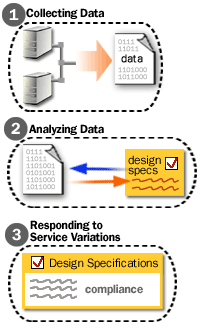What are the criteria for successful network Performance Management?
The client's network must perform at the level they need for the price they are willing to spend. There are obviously practical limitations to what you are able to do as a solution provider. For example, you cannot make a DSL line go faster, but you can manage the bandwidth available on it, so you can potentially provide a modest apparent improvement. If the client can only afford a DSL line, and you can make that line perform as well as it can, that is a successful project.

- Provides information on network status The data needed for establishing a networking plan includes information about the present network infrastructure, the hardware and software environments of the network clients, and any current problems with the efficiency or reliability of the network. Distributed Network applications such as Microsoft Systems Management Server 2.0 collect this data in an automated and timely fashion.
- Evaluates the information specified in data collection against design specification. Once it is collected, you need to analyze the data to pin-point trouble spots that need attention before implementing Windows. Programs such as Microsoft Systems Management Server provide excellent reporting capabilities that speed up and ease this analysis of networking components.
- This brings the services back into compliance with design specification. For example, the design plan may include a minimum bandwidth requirement of 10 Mbps connections for the local LAN environment. If you have segments on the network that are using old version of 4Mbps token ring architecture, you must upgrade them to a network architecture that supports at least 10 Mbps.
Elements of the Local Area Network
- The Local Area Network (LAN) refers to the system of electronic devices and cabling that connects individual hosts (computers, printers, etc.) in a unit to each other and to the backbone network. The backbone network in turn provides connections to other hosts within the system, and to the internet.
- The Distribution Layer Switches are the physical presence of the backbone network in each building. They are connected to two different backbone switch-routers so that the failure of a single distribution layer switch will not cause the failure of the backbone network connection to the building.
- Vertical Distribution Cabling provides connections between the backbone distribution layer switches and local wiring closets. Vertical distribution cabling may be fiber optics or any of several types of copper cabling.
- Access Layer Switches are provided by individual units.
They are typically located in wiring closets and are connected to the distribution layer switches via the vertical distribution cabling. They provide network connectivity to the hosts in their area. Other devices, such as uninterruptible power supplies or power over ethernet devices may be associated with the access layer switches for particular applications. Horizontal Distribution Cabling provides connections between the access layer devices and the local hosts. It typically terminates at a patch panel in the wiring closet at one end, and at the wall jack in offices and classrooms at the other end. Various types of patch cables and drop cables are used to complete the connections to the access layer switch and the local host.
Elements of the building's infrastructure, such as wiring closet ventilation, and electrical power affect the functioning of all of these elements and may constrain your design.